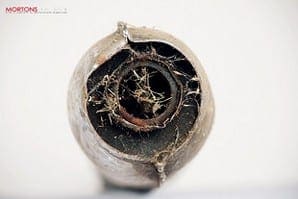
There are now no longer any hard and fast rules to decoking two-strokes and the changes in two-stroke oil technology since the 1970s means a one-size-fits-all approach is no longer viable.
Before the advent of ester-based synthetic oils it was pretty much guaranteed that the time-honoured caustic soda de-coke method worked.
This strong alkali reacted with the acid components of the partially burnt oil forming a soap allowing the sticky carbon from the silencer and baffle surfaces to be washed off.
This method still works well for older type two-stroke oil deposits but is of limited use if your bike has been run exclusively on modern synthetic oil. The corollary of this is that modern oil shouldn’t coke up silencers anyway and therefore there’d be little carbon to remove.
Working on the premise that few of us know what oil our bikes have been run on since the 1970s we’ll have a look at some of the options and techniques that we may need to employ in order to evict those nasty, sooty, power sapping deposits.
I’ll be looking at several stink-wheels’ pipes to illustrate various topics and in some cases will be wading into some Eastern European machinery, so for those readers of nervous disposition who don’t want to see an MZ; look away now.
 A two-stroke’s baffles perform one specific purpose; they reduce the level of exhaust noise. This is achieved by slowing down the gas flow via pressings, drillings, flutes etc along the baffle’s surfaces and in doing so partially combusted oil is deposited. This collects in ever increasing amounts which in turn increases the baffle’s surface area which further damps down exhaust noise and inexorably traps more carbon; so the cycle perpetuates and the exhaust gradually chokes. A lot of exhaust decoking issues are attributable to blocked baffles and this is always the first area to look at.
A two-stroke’s baffles perform one specific purpose; they reduce the level of exhaust noise. This is achieved by slowing down the gas flow via pressings, drillings, flutes etc along the baffle’s surfaces and in doing so partially combusted oil is deposited. This collects in ever increasing amounts which in turn increases the baffle’s surface area which further damps down exhaust noise and inexorably traps more carbon; so the cycle perpetuates and the exhaust gradually chokes. A lot of exhaust decoking issues are attributable to blocked baffles and this is always the first area to look at.
Wherever possible remove the baffle from the bike while the exhaust is still fixed to the bike; this gives you much more leverage. If you can evict the baffle when the exhaust is hot even better as it should be looser. Later strokers often have a crosshead inside an annular chamber that’s perversely located at 45 degrees to the ground. so a magnetic screwdriver is very useful here as it will stop the screw from getting lost inside the silencer.
How you clean baffles depends on the type of oil contamination. However, the time honoured method of a wire brush and a gas torch are still valid providing you take the obvious precautions. Once coated in oil and soot this material makes an impenetrable barrier to exhaust gases and cannot be cleaned. Removing the wadding gives access to the all important passages.
Post cleaning I’ve always left the baffles naked and have suffered no problems but you might want to check with owners of similar machines just to ensure there are no issues with your particular machine. If you do choose to re-wrap the baffle, fibrous loft insulation material makes a very useful alternative to the factory stuff but you can purchase specific wadding (many motocross dealers stock this).
Caustic soda
The old standby of caustic soda (not washing soda) will make a fairly reasonable impact on traditional 70s two-stroke oil residues but depending on the level of contamination its effects may be limited.
 Caustic soda needs to be treated with care as it will burn the skin and eyes. Safety glasses and disposable gloves are the minimum level of protection; a face-shield and strong rubber gloves are the preferred option. Dissolve the caustic by adding it to lukewarm water. NEVER add water to caustic as it will become incredibly hot and possibly effervesce. A 10 percent solution is generally sufficient for most applications. Caustic is available from hardware stores and commonly used to remove fat and grease deposits from pipes and drains; a use not too far away from our own.
Caustic soda needs to be treated with care as it will burn the skin and eyes. Safety glasses and disposable gloves are the minimum level of protection; a face-shield and strong rubber gloves are the preferred option. Dissolve the caustic by adding it to lukewarm water. NEVER add water to caustic as it will become incredibly hot and possibly effervesce. A 10 percent solution is generally sufficient for most applications. Caustic is available from hardware stores and commonly used to remove fat and grease deposits from pipes and drains; a use not too far away from our own.
The smaller end of the silencer should be blocked with a rubber or silicone bung; don’t use real cork as the caustic will cause it to leak. Tight fitting wooden plugs or even a large spud rammed well home will also suffice. Carefully pour in the caustic mixture and ensure the silencer is totally full. Place the silencer in a bucket and ensure it’s secure and cannot fall over. Leave the silencer to soak for 24 hours and then pour the caustic into the bucket, wash out the silencer with a hose and allow to dry. Post cleaning a good poke with a bottle brush, long handled wire brush or similar will help dislodge large lumps of loosened carbon. This process will make some good inroads into a well used silencer but if badly clogged one or more alternative methods may also be needed.
 Solvent cleaning
Solvent cleaning
This method can prove to be very effective on silencers coated in treacly oil deposits and heavy oil-soaked carbon. It also works on more modern oils that cannot be saponified with caustic soda. Never be tempted to use petrol to degrease a silencer; it’s not nice stuff to handle in bulk, shouldn’t be inhaled and has very obvious flammability issues. Start again by plugging the narrower end of the silencer but avoid rubber as our solvent brew will cause the rubber to fail.
With the silencer suitably secured and held safely upright add a 50/50 mixture of white spirit and old brake fluid (if you’re feeling rich you can splash out on a 5 litre container of the cheapest glycol based brake fluid you can find). The combination of the two solvents is extremely powerful and together they will solvate and dissolve the bulk of the oily crud. You’ll find the process can be helped along by carefully inverting the silencer occasionally to allow the solvent to move around and evenly dissipate the oil throughout the mixture.
It’s worth remembering that the time needed is proportional to the level of oil and carbon. As an example, a pair of extremely restricted silencers clogged with late 1960s oil were left soaking for two weeks. After two weeks the silencers were removed from their temporary home in a warm shed, emptied out and flushed through again with the same fluid. A good 85 percent of the contamination was removed and the balance evicted with a 24 hour caustic purge. Rinse silencers through with a hose and allow to drain.
Please note, if your exhaust is painted matt black, prolonged contact with brake fluid may cause staining or paint damage (chrome systems are unaffected).
 Detergent cleaning
Detergent cleaning
This method is effective with more modern oil residues and works well in conjunction with the solvent method. Bikes run on fully synthetic oil in theory shouldn’t be too bad in terms of exhaust debris but unless given the berries and allowed to breathe deeply that ultra-expensive but partially combusted two-stroke oil can cause problems. Similarly many 1980s restricted slo-peds never really got a chance to rev at full bore and their exhaust systems are often clogged with oily sludge. With the exhaust plugged with anything that can withstand a bit of heat add a brew of piping hot water and detergent. Experience has shown that pine based industrial detergents used for floors seem to be the best.
Normally a 10 percent solution works fine and you should see large globules of oil quickly rising to the surface. If you’re unable to source industrial detergent some non-bio domestic laundry detergent will make an acceptable substitute. The longer the solution stays hot the better so if you can do this at the height of the summer and wrap the silencer in some old rags to retain the heat the effects are definitely enhanced. Once again rinse through with a hose and allow to drain. ![]()












